#Wasps Built Their Colony
Explore tagged Tumblr posts
Text
WASP REVIEW - VESPIQUEN LINE (POKÉMON)

[Image ID: An official render of Vespiquen from Pokémon /End IDs.]
Buzz buzz buzz, hey howdy everyone and a very merry Wasp Wednesday to those who celebrate! This time around, we return to the old Pokémon well with one from back in Generation 4. A fascinating design, truly, with multiple possible origins, but how does it compare to the real thing?
Starting out, as usual, with its appearance; We can see that Vespiquen has the correct number of wings, keeping up the wing count streak from Beedrill! Unfortunately it only has one pair of legs, and I don't see any of the requisite 3 ocelli on its head. Interestingly, in place of these ocelli is what appears to be a jewel? This is a part of a structure on its head that either is or heavily resembles a piece of old high-class headwear (with Bulbapedia specifically comparing it to an escoffion). Whether or not they are wearing this or if it is part of their body is unclear, as tends to be the case in the Pokémon franchise given their wishiwashi- err- Excuse me. Their wishy-washy history, or lack-thereof, of explaining Pokémon pseudo-clothing.
The eyes that are there are way too small if we assume a Vespid or Apid inspiration, and they honestly appear more vertebrate-like in structure, although I can't honestly tell whether the white part is supposed to be a reflection or a pupil. Furthermore, we can see that Vespiquen has no antennae, which is quite strange for an insect; Perhaps it has another, similar adaptation? The antennae could've even morphed into the horn-like shape of the "crown" during the evolutionary process. The mouthparts, meanwhile, equally appear to fall into this particular trap, as it seems to have no mouth at all, but its headgear has a structure that sort of resembles the missing mandibles.

[Image Source: Texas A&M AgriLife Extension, Salvador Vitanza | Image ID: A photo of the head of a yellowjacket species, Vespula pensylvanica, a social Vespid /End IDs.]
Moving onto the body, and the whole deal of pseudo-clothing comes back again, although, this time its connection to the body is more clear. Vespiquen is seen with an umbrella-shaped nest, looking like a dress or gown, wrapped around a more standard Hymenopteran body shape, with the Pokédex entry in Pokémon Diamond stating: "Its abdomen is a honeycomb for grubs". Now, the connection to honey bees is clear, however, I would much sooner compare her main body shape to that of Polybia paper wasps or Sphex thread-waisted wasps, and the shape of her built in nest to that of Polistes paper wasps.



[Image Sources: iNaturalist, limarrudandre; iNaturalist, Larry Clarfeld; Wikimedia Commons, Bob Peterson | Image IDs: Three photos, one of an individual of the species Polybia sericea visiting a green plant, another of a Great Black Digger Wasp, Sphex pensylvanicus, visiting some yellow flowers, and another of the nest of a colony of Horse Paper Wasps, Polistes major major, showing its umbrella-like shape /End IDs.]
Thankfully, this design has a clearly three-segmented body, with its head, mesosoma (functional thorax; thorax and propodeum), and metasoma (functional abdomen; petiole and gaster) all seeming fairly distinct from each other. Proportionally, the head is a bit small in comparison to the body, and the same, in my opinion, is true for the wings. The legs, as few as they are, are an alright size, but aren't properly segmented.

[Image Source: bugguide.net | Image ID: An illustrated diagram showing the legs of three Hymenopterans, the first two being of other wasps, while the last one is of a bee, with each segment labeled. Coxa, trochanter, femur, tibia, and tarsus, with metatarsus on the bee. /End IDs.]
Back to its "dress" before I move on; I'm very curious as to what sort of texture it has and what material structure it's made out of. In the Pokémon universe, the answer could really be anything, but the real world equivalents of Vespiquen would either have nests made of wax (honey bees) or nests made of paper (the aforementioned paper wasps, as well as members of Vespinae, such as yellowjackets and hornets). Perhaps it could be one of these materials, or maybe it's a thin layer of chitin, as a more direct part of its exoskeleton?
But if Vespiquen is both the queen and the nest itself, then what about the colony? Well, this Pokémon evolves directly from Combee, specifically a female Combee exclusively!

[Image ID: An official render of a female Combee /End IDs.]
I won't spend too much time on this particular design, but, from what I've already said, you can likely tell this is much less accurate. In exchange, the design is that much more fantastical in nature. Here we see three individuals connected to each other by combs made of either wax or, again, chitin; Each of the upper two bees has a singular antenna and wing, though they don't seem to have a full body. The one on the bottom, however, has a body, but the segmentation is unclear and it still does not have any legs. If it's female, this one also has a red patch on its forehead, while the males do not have this at all. Finally, all of them have two, far too small eyes, and strangely mammalian mouths.
Well? What of the behavior of this colony then? Well, as we already know, Vespiquen is the queen of the hive, as well as being the hive itself. However, the system of their sociality is quite unique from that of honey bees or even of Vespid wasps. Each colony might contain hundreds of Combee, however, these Combee aren't necessarily the offspring of the Vespiquen, as its Pokédex entry from Pokémon Shield states: "Vespiquen that give off more pheromones have larger swarms of Combee attendants". This implies that some Combee might be summoned into the colony, rather than being born into it.
Furthermore, the Pokédex entries from Diamond, Pearl, and Platinum read as follows: "Its abdomen is a honeycomb for grubs. It raises its grubs on honey collected by Combee"; "When endangered, grubs from its six-cell honeycomb strike back. There is only one in a colony"; "It releases various pheromones to make the grubs in its body do its bidding while fighting foes". These entries confirm that, for one, the Combee will collect/produce honey, thus also providing the ecosystem service of pollinating, while also confirming Vespiquen also produces at least some of the offspring of the colony. However, the fact that they specifically state that the grubs "strike back" or "do its bidding" is highly confusing. In the real world, larvae of social wasps such as paper wasps, yellowjackets, hornets, and honey bees (among multiple other examples) are wingless, stingless, and barely move.

[Image Source: Wikimedia Commons, Waugsberg | Image ID: A photo showing eight bee larvae arranged in order of age as they mature and harden into their pupae /End IDs.]
It implies that their young have some form of defensive abilities. But not only that, it implies that these Pokémon should have an additional life stage, possibly even two additional life stages, as the larvae reasonably should hatch from eggs (as Pokémon are known to do), live as larvae for a while, and then form pupae, before developing into adults. This part is made even more strange by the fact that fully formed, adult Combee can be hatched from an egg—Which brings me to my next point of discussion, that being, both male and female Combee are fertile, and do not need a Vespiquen, nor even another Combee for that matter, to produce offspring. This is strange, seeing as drone bees (as in; Male bees), as is true for male wasps in general, are fertile, while worker caste female bees are not fertile, with the males requiring a queen in order to mate.
Interestingly, regardless of level or sex, Combee cannot learn Poison Sting, which implies that even female Combee do not have a stinger until they evolve into Vespiquen. It makes sense for male Combee to be incapable of learning the move, as drones do not possess the ovipositor necessary to deliver a sting; However, if a Combee is a fully formed adult, as it appears to be, a female should be perfectly capable of performing this move. This could help explain why they join together with Vespiquen, it provides extra protection, as it can learn Poison Sting, and would be able to sting repeatedly in the real world even if it were a honey bee, as a queen is capable of delivering multiple stings due to having a stinger that is far less prone to getting caught on skin.
Well, at least that's all of the confusion somewhat settled when it comes to the social structure of these colonies, right? Right? WRONG. Because if we have Vespiquen, male and female Combee, and the as of yet unseen "grubs", then what, might I ask, are these?

[Image ID: A screenshot of a Pokémon battle, in which a swarm of non-Combee bees has surrounded the opponent due to Vespiquen using the move Attack Order /End IDs.]
"Oh, but Miss Jupiter, this is just the visual effect associated with some random Pokémon move, surely it doesn't mean anything about Vespiquen specifically!" is something you might say, and normally I would be inclined to agree with you, if not for the fact that this is one of Vespiquen's signature moves. Literally no other Pokémon in the games, barring maybe another Pokémon using something like Mirror Move or Mimic, can actually learn Attack Order—Only Vespiquen can ever learn this move naturally. The implications of this are fascinating, given that these bees CANNOT be fully formed Combee, as there's only one of them, but they also can't be the aforementioned "grubs" given the fact that said larvae shouldn't have wings or that distinctly adult body. So then, this species has four or even five distinct castes (depending on the possible sexes of these bees)? Why are these not their own Pokémon as well? Are these all Vespiquen's offspring, as they should be, or are they also attracted to its nest via pheromones? Are these just separated Combee?
This strikes me with another question too; What happens to the other two bees when a Combee evolves into a Vespiquen? Perhaps they separate and the other two become dedicated workers, part of this swarm, or maybe they outright fuse together into one, singularly thinking organism. Regardless, I'm... Confused.
In the end, I suppose that things could be worse, but it's just not very good, to be honest. It's as fascinating as it is confusing, which is to say, very. Of course, this is honestly fine, given that it's Pokémon and it's really not meant to be accurate, but it's a bit disappointing even compared to Beedrill. So, my rating would have to be...
-
Overall: 3/10
-
Leave your wasp review suggestion in the replies, tags, or askbox!
32 notes
·
View notes
Text
Bee Keeper Mountain
CW: Winged Insects (pictured are only bees though, some piled on a hand at the very end of the post)
Mountain has several traditional, if customized, beehives out on the ministry grounds but an indoor hive for his favorite bee folk, that he built with Aether, as well. He loves watching them and being able to hear the buzzing when he takes a midday nap. It's like white noise to him.


He also has a freeloader of a roommate. No, not a ghoul. A blue carpenter bee that lives in a hole in his antlers. Mountain calls him Bee-casso.


Mountain obviously makes his own honey. Aside from the regular ones, he's working on perfecting a kind with very special properties for ghoul illnesses, made from plants he crossbred and cultivated himself. Rumor has it they're stemming from seeds from the pit. Mountain never confirms or denies those rumors.
When it's his turn to make breakfast or snacks, he serves honeycombs with it. (He snacks on them while harvesting them, too.)


The earth ghoul makes sure his bees have a diverse flower buffet to choose from by making little seed balls and handing them out. He personalizes them too, based on seasons and the being they are intended for. When he sees a certain patch growing, he'll know who "lost" their little balls there. Swiss and Aether take it as the perfect opportunity to make ball jokes. To no one's surprise.


Mountain, ever the protector of nature, is also the one that insists on gently resettling Hymenoptera colonies that built their home in hidden alcoves throughout the ministry grounds, such as the kitchens and the sibling dining hall. All are done by hand to ensure none of the little critters get injured.
Once, a group of siblings poisoned a wasp nest, and Mountain was so upset that he didn't talk for a week. The disappearance of the responsible siblings is deemed just a simple coincidence.


#Mountain Ghoul#nameless ghouls#ghost ghouls#the band ghost#ghost bc#ghost band#scribbles#Mountain my beloved#this is self indulgent af and kind of silly and unsurprisingly will only appeal to me but I needed to get this out of my head#ghost headcanons
56 notes
·
View notes
Text







Great Golden Digger Wasp - Sphex ichneumoneus
I wasn't intending on uploading these images today, but Tuesday's weather in Toronto has been magnificent and warm. It reminded me of summer, and these beautiful pollinators that graced the neighborhood's small flowers. I'm always amazed by the expressive faces these splendid insects showcase while observing them. Although they may seem intimidating at first glance, just a friendly reminder that these beauties tend to not be aggressive when far from their burrow, unless provoked. This Wasp's first form of defense is her ability to fly away from danger. Secondly, while her mandibles appear fearsome, at maximum extension they are built to grip and haul, rather than rip and tear. Furthermore, as this solitary Digger Wasp's sting is designed to prick and paralyze Katydid prey, its pain level to a human may be weak compared to other Wasps; especially the species that have colonies ruled by a queen such as Yellowjackets. In looking for a reasonable measure of the pain/effects that this Wasp's sting could bring, my attention returned to "The Sting of the Wild", by Justin O. Schmidt.
While the Schmidt Pain Index included in the book doesn't mention the Great Golden Digger Wasp, it does outline the strength of one of its close, North American relatives: the Great Black Wasp (S. pensylvanicus), a close North American relative of the Golden Digger. Its sting is rated a 1 out of 4. For a comparison, a Yellowjacket sting is rated at a 2. As well, the Golden Digger's sting is described as follows: "Simple and presumptuous. Your younger sibling has just nipped at your pinkie finger." It doesn't sound so bad, but indications of a sting will occur in the form of swelling and possible discomfort. As such, it is best not to provoke insects into biting, scratching or stinging you. Kindly allow them to go about their day with minimal interference (when possible). Having said that, it is likely that they may engage in conflicts with other Wasps while foraging should they get too close to each other, whether on flowers or on the cornering of a paralyzed Katydid. Any fighting is likely to be mostly nipping, poking and grappling, the latter two of which are done using the long, spined legs.
Pictures were taken on July 1, 2024 with a Google Pixel 4.
#jonny’s insect catalogue#ontario insect#wasp#great golden digger wasp#digger wasp#insect#hymenoptera#toronto#july2024#2024#nature#entomology#invertebrates#arthropods#photography#animals
12 notes
·
View notes
Note
Hey Memento Mori I would like to ask you did I can know more about culture and history of each sapient species? And how long each them live , when they hit their equivment of 18,30,35,40,50,60,70,80,90 and 100? Sorry If I made you angry fir so many questions or anwers are arleady here.
I'm never upset about questions! This project is a passion of mine and I could info dump about it all day lol.
Gimme a bit to prep all the info and I'll reblog this with more stuff later, but for a quick answer on ages at least, here are the main people species from shortest lifespan to longest lifespan:
- pixies, which are giant sapient insects in the same family as bees/wasps/ants, individually live around 10-15 years on average. Queen pixies live longer, with an average age of 25 years, and male pixies have the shortest lives at about 6 months from the time they complete pupation into an adult form. Males only biological purpose is to mate and then die, as is common in many eusocial insect species. But their short lives are not used to dismiss or abuse them, as they are considered highly important and given a great deal of honor and ceremony. Pixie hives claim a much longer lifespan as a collective whole, because they are mysteriously able to share memory with each other and this hive memory is passed along through every generation.
- goblins, which are a type of amphibian, on average used to live only 50 years, but since the time of the goblin revolution, they have begun to live longer, reaching 80 and even 90 years at the oldest. This shift in life expectation is attributed to the increase of mutual care between people species, which accelerated the advancement of medical science. It may also be attributed to those goblins that skip winter hibernation by staying in the warm homes of their mammalian friends during the cold months.
- quetzalin, the bird folk, live around 100 years at best, though most die in their 80s or 90s. They are far more physically active and have a high metabolism compared to many other people species, which contributes to their relatively shorter lifespan.
- coastal merfolk, centaurs, gnomes, and orcs all tend to live between 100-150 years of age. The orc who dies at the beginning of my story, He-esh, lived to 150 (subject to change based on other timeline details, but 150 was my original plan). All of them are mammalian species with hardy bodies built to withstand difficult environments and changing seasons. The coastal merfolk are pinnipeds (related to seals and walruses and sea lions) while the centaurs are descended from chalicotheres and the orcs and gnomes are of the same family as pigs.
- dwarves on average live between 200-250 years of age. They are actually the last remaining hominid species, more closely related to Neanderthals than homo sapiens, and they are also built quite sturdy with a more durable metabolism than the modern human.
- elves, stroi, and drow, the primate sylvanid family, all tend to live up to 500 years at best, with the elves often outlasting their cousin species. However, more recent studies have found that the sylvanid lifespan is slowly decreasing. This may be attributed to higher activity in the younger generations which has altered their metabolism, and this change of activity was mostly brought about by an increase of interspecies interaction, as younger sylvanids are spending more and more time in diverse communities. It is now speculated that the most recent generations may only live to 300 years on average.
- one exception to the longer lives of sylvanids are the drow matriarchs, who give birth to every child of their colony. They are a eusocial mammal species, with the majority being infertile and males being less common. Matriarchs tend to have a shorter life expectation due to the physical exertion of giving birth so many times. They're not built for it quite as well as pixie queens are, and frankly the pixie queens only need to lay a lot of tiny eggs, while drow matriarchs give live birth, the majority of which are twins. On average, drow matriarchs undergo their unique secondary puberty at 50 years of age and typically give birth once a year for 100 years, at which point they undergo menopause and face a swift health decline, living to the age of 200-250 at best.
- the ogres, a mountain dwelling species of sapient giant sloths, have the longest lifespan of any people species, living around 800 years on average. This extremely long life expectancy is attributed to their much slower metabolism and relaxed lifestyle. However, many people forget that ogres have such long lives because they are often viewed by others as less intelligent due to their seemingly limited vocabulary and their lack of collective settlements or even large nomadic camps. They tend to live in very small isolated groups that only travel a little to gather with other ogres for holidays or to trade with other people. They interact the most with dwarves, who live in their territory. Ogres will frequently leave their more vulnerable young ones in dwarf caverns for safety.
5 notes
·
View notes
Text
Because you wanted it (I secretly did too. I love wasps)
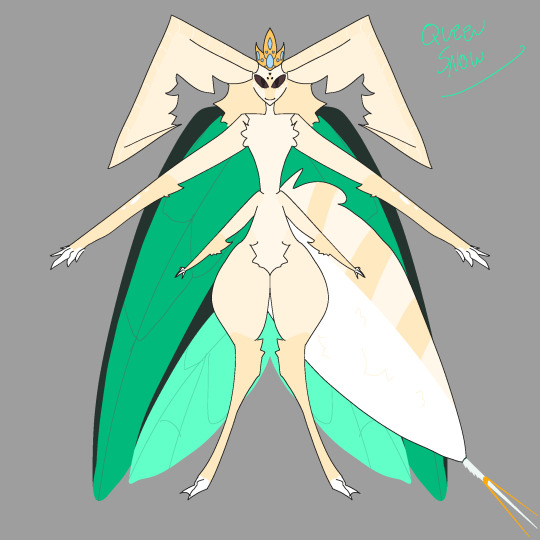
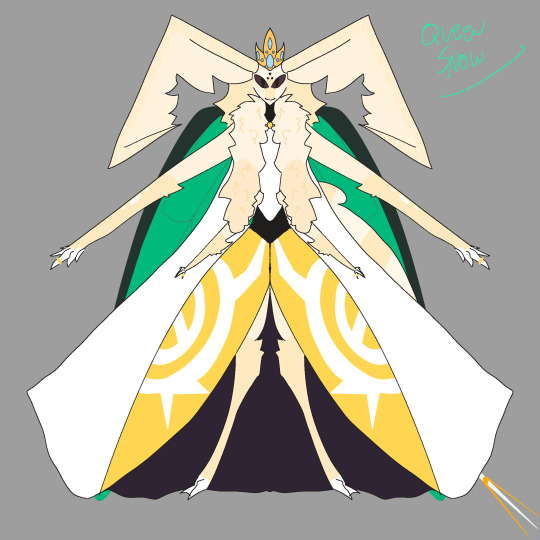

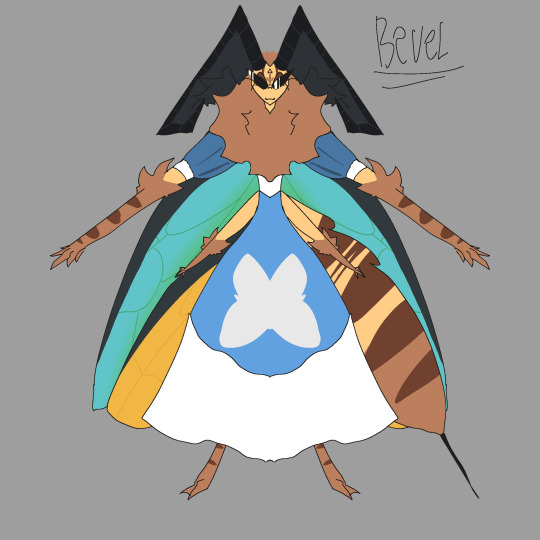
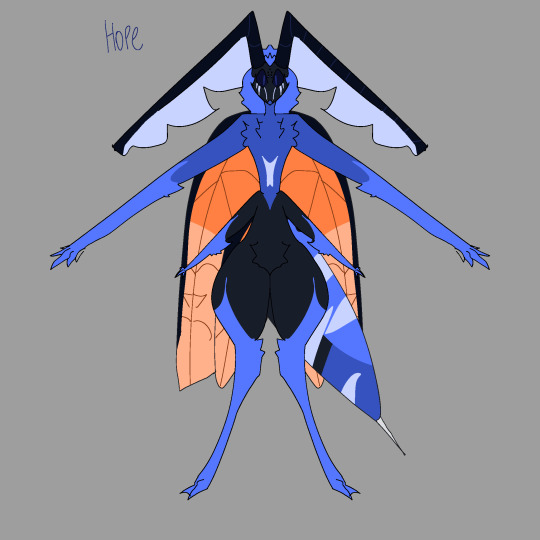
Just like how I did it with the spiders, i’ll be explaining the wasps, not not a lot of history (Too complicated)
Their diet consists of mostly meats. Maggots are considered a delicacy in their kingdom, the maggot is usually snatched and beheaded before being served. They do incorporate plants into their food, like native Waspian fruits and vegetables. They seem to have a love for topping everything with basil (A basil-like plant that could be classified as a type of basil with bigger leaves. The plant does have thorns, so it’s not really basil)
The Waspian society is similar to the spiders. The queen MUST be a pure bred wasp, or a wasp with no other things mixed in. The queen controls everything and everyone, but the wasps can leave the colony if they feel like it. Wasp City IS NOT the only colony in their territory, it’s just the most popular and largest. A heir can take the throne by either killing the queen, but that’s seen as a very unfair method for other heirs. If the queen survives 50 winters then she is kicked off the throne or can choose to stay till she dies. Another way for a heir to take the throne is by secretly murdering their mother and making it look like an accident then propose they should take the throne in her honour. Still unfair, but at least they won’t be seen as a murderer. But the worst way is accidentally slipping on a puddle of water holding a plate WITH A KNIFE ON IT and then accidentally stabbing their mother, and then sob over her dead body because they’re too young to be queen... and miss their mother. That’s only happened once like at least in ancient times. Hierarchy - The queen and her heirs, people workings in her majesty’s army, citizens who have jobs, normal citizens and princes, homeless, war prisoners and normal prisoners.
As a side note, all other species fear wasps and spread propaganda about them. The common wasp stereotype is being bloodthirsty, angry, recklessly, and a ravenous murderer.
The wasps are as diverse or more than the spiders. They can ranges from yellows and browns, to blues and blacks, to reds and oranges, greens and whites. Queen Snow is not a normal coloured wasp, I thought it was cool to make her an albino wasp, WHICH IS VERY, VERY, VERY RARE. Pure bred have ancient Waspian traits like less curled antennae, serrated stingers, sharper features, and a sharper face. Impure have different species traits which include bigger eyes and a smooth, thick stinger. They can also possess no fur on their antennae or have smaller wings. They used to not really crossbreed with other species because the offspring usually die from complications but apparently they kinda learned to just cast a whole enchantment on the continent which would allow all hybrid offsprings to live a normal life. This is why some spider-wasp hybrids exist.
I JUST SAID I WASNT GONNA GET INTO THAT MUCH HISTORY
Anyways, let’s go onto some random information that didn’t fit in the three categories.
Wasps are one of the first species to hypothesise that only some people were born with the ability to enchant things and some weren’t.
Wasps are deeply related to hornets, since hornets branched off of wasps when some prehistoric species of wasp decided to ditch the colony and move to a different continent.
Wasps can see the widest range of colour which is why their paintings make other species eyes hurt trying to comprehend them completely.
Wasps have been painting since they were an early species because they wanted to show other species what things looked like on their continent.
The native language of the wasps was too complex for other species to even learn how to say “Good morning” so an ancient spider tried to convince them to learn the mostly universal language. The native language is still taught, after the age of 15 winters, they will start to learn the universal language as a second language
The wasps palaces are built using precious building materials like limestone, quartz, and reinforced gold for spectacular displays of their culture on the palace. The palaces also full of open windows and areas where wind passes through. Not related, but wasps are taught how to fly by LITERALLY THROWING THEM OFF THE HIGHEST LEVEL OF THE PALACE!
If you want me to draw another bug/base, put it in the comments
#my art#artwork#art#illustration#digital art#artists on tumblr#artists of tumblr#bugs#wasps#wasp#insect#insects#oc#oc art#my ocs#original character#ocs#drawing#character art#my characters#original characters
24 notes
·
View notes
Text
Concept art for a new species within the Sunset Sands Sinematic Suniverse: Mechins (pronounced meh-kin). More worldbuilding details below images.
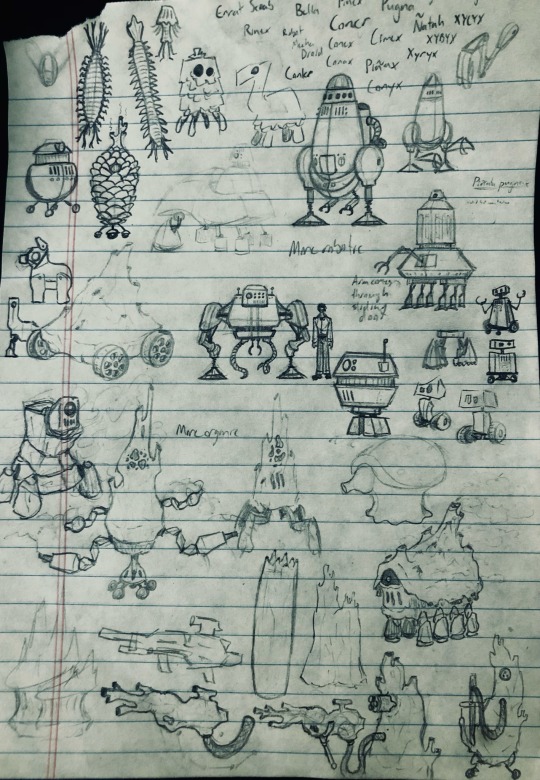
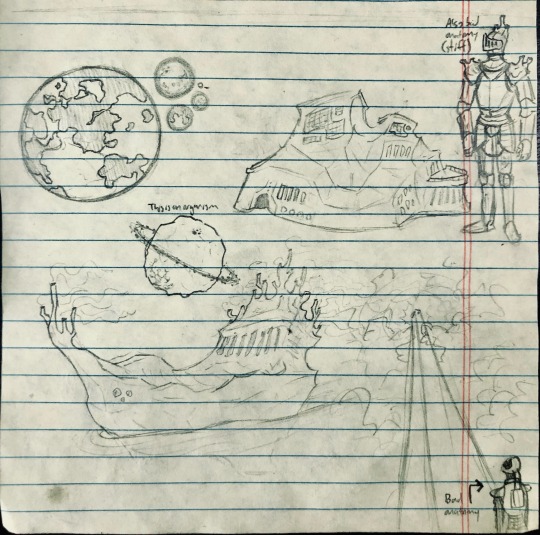
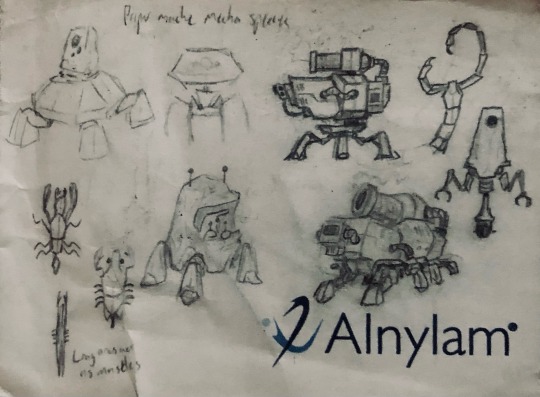
I’ve had this idea for a while, but this is my first time trying to put it to paper. The basic concept is that they are mobile structures made of a wood pulp/paper mache-like material, analogous to termite mounds or wasp nests. The eusocial bug-like creatures that built and lives inside the structure have highly specialized castes for each of its necessary bodily functions, filling the roles of muscles, nerves, and connective fiber. Though none of these creatures are sapient on their own, they come together to form an intelligent collective conscience, that being the mind of the mechin itself.
Because the shape and structure of the hard outer parts is not determined by the resident creatures’ DNA, mechins can take on a near infinite variety of sizes and body plans. They may also incorporate materials besides just the aforementioned wood pulp, such as glass or metal, if they come across it.
The outer shell may take a more sleek, robotic form or a bumpier, organic form. This is more a matter of personal preference than anything, with tendencies from one to another varying greatly depending on region and cultural background.
The social structure of mechins is a bit more solitary than humans, with some individuals, especially larger ones. behaving and being viewed as more as nations than people. They are highly protective of the land they claim and the resources held within, and will fight off any unwanted invaders that may enter, often with weapons built into their bodies. If another mechin is found to be trustworthy, they may form an alliance, with larger alliances comprising possibly thousands of individual colonies. Alliances between mechins are technically a form of polyamorous romantic relationship, and behavior between allied mechins is usually more flirtatious than diplomatic.
The mechin reproductive process involves two or more individuals within an alliance first gathering the materials required to build the outer shell, mostly just plant matter and small bits of metal. After that, one adds a queen to the materials while the others each add a few drones. These initial organisms will give way to a generation of nerve, connective, and muscle organisms which will work together to construct a starting body for the colony-to-be. The structure of the newborn mechin is not set for life, and may be expanded and renovated in accordance with current tactical needs or fashion trends.
Mechin gender is determined by their preferred way of interacting with other mechins, and may change many times over the course of their lives. The long list of meche genders includes but is not limited to “warlord,” “diplomat,” “pacifist,” “isolationist,” and “economist.” It is generally expected that alliances will occur between mechins of the same gender, but straight relationships are not too uncommon.
The mechin homeworld, Borgam, is hotter than, drier than, and about 1.25x the size of Earth. It has five moons of varying sizes and orbits a pair of red stars. I have not yet put much thought into the resident flora and fauna of this planet, but I do know at the very least that there are a few species of eusocial centipede, which are relatives of the species that gave rise to the mechins.
That is all I can currently think to say about these things. Like all of my other assorted worldbuilding messes, I will add onto this post later if there is anything interesting I can think to expand on.
#art#my art#spec bio#speculative biology#alien#xenobiology#worldbuilding#pencil on paper#mechin#borgam
17 notes
·
View notes
Text
October 30th, 2023

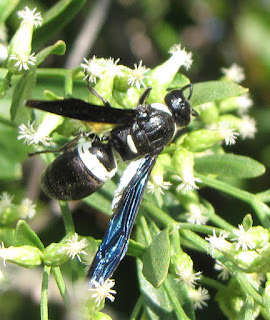
Four-Toothed Mason Wasp (Monobia quadridens)
Distribution: Found throughout eastern North America, from southern Canada down to Mexico.
Habitat: Usually nests in wood borings or dirt banks; also occasionally takes over the nests of carpenter bees, ground bees and mud daubers. Prefers meadows and woodlands.
Diet: Adults feed on nectar; larvae feed on caterpillars.
Description: The four-toothed mason wasp is a non-aggressive, solitary potter wasp, though it's often mistaken for the more aggressive bald-faced hornet, sporting a similar size and color. Because of its solitary nature, however, the four-toothed mason wasp doesn't have a colony to ferociously defend like the bald-faced hornet does; for this reason, it only tends to sting when provoked.
Though adults are herbivores, larvae feed mainly on caterpillars. After a female wasp builds her nest, composed of small cells built into abandoned holes (such as the nests of other bees and wasps) or hollowed-out stems and tree branches, she will lay one fertilized egg per cell. Then, she will hunt for caterpillars, which she paralyzes with her sting, before bringing them back to store away with her eggs. Once hatched, the larvae have everything they need to grow and pupate, all within the same cell, before finally emerging as adults.
(Images by Sandy Rae and Eric R. Eaton)
30 notes
·
View notes
Text

Hellwasps, also known as hellwasp devils, were insect-like fiends that inhabited the warmer levels of the Nine Hells.
Hellwasps were large insects with a tough carapace and strong legs that ended in natural piercing weapons shaped like scimitars. The wings were thin and appeared to be made of metal. At the tip of the abdomen was a large stinger. Colony guards were somewhat smaller than the "devil" variety.
Hellwasps were vicious, hateful, and aggressive creatures.
The carapace of a hellwasp was susceptible to cold and the creature's metabolism required a warm climate to function properly, so they avoided places in the Nine Hells that were extremely cold, such as Cania and Stygia.
In addition to feet sharp as talons, hellwasps could sting a victim, injecting a fiery poison on a successful attack. This venom not only burned like drops of alchemist's fire but could slow or paralyze a creature for up to a minute, allowing the hellwasp to carry the victim away to be devoured later. If colony guards were available, they swarmed a group of enemies, attempting to sting them into paralysis for the larger devils to carry off.
Hellwasps lived in colonies, typically with ten to twenty adults that all shared duties equally. They communicated via their own version of telepathy that had a range of 300 ft (91 m). Some sages believed there was a queen that all hellwasps would serve with unswerving loyalty if called upon.
Hellwasp colonies built nests for communal protection, food storage, and for raising their young. Adults regurgitated a sticky bile that typically contained fat, bone, and sand that was light, strong, and the color of amber that they used in construction. A nest had multiple chambers connected by twisted tunnels, each dedicated to a single purpose. One chamber contained octagonal cells for individual adults, another (centrally located) chamber was the hatchery where the larvae were tended. Also, there was usually a larder room for storing food (victims, alive or dead). Hellwasp grubs were placed inside the bodies of victims stuck to the walls to feed.
In Avernus, hellwasps preferred to embed dead angels or other magically buoyant corpses in the walls of their nests. When enough bodies were attached, the nest lifted off the surface and had to be tethered to the ground to prevent it from drifting off. Once this was accomplished, the hellwasps made the underside of the nest the only entrance.
In the World Axis view of cosmology, sages believed that Glasya, the daughter of Asmodeus and Lady of the Sixth Hell, Malbolge, was responsible for bringing the hellwasps to the Nine Hells from one of the other Lower planes. The theory states that they were a type of fiend, similar to mezzodemons, that followed a wasp-like demon lord. After she defeated their lord in a Blood War battle in the Abyss, they hailed her as their new queen and followed her back home. She transformed them into devils and let them nest in her Garden of Delights. These hellwasps served Glasya willingly and would only take orders from others if she allowed it.
Source: https://forgottenrealms.fandom.com/wiki/Hellwasp
5 notes
·
View notes
Text
WASP REVIEW - DEEPTORA BOUGH WASPS & DEEPTORA HONEYCOMB BEES (DEEP ROCK GALACTIC)
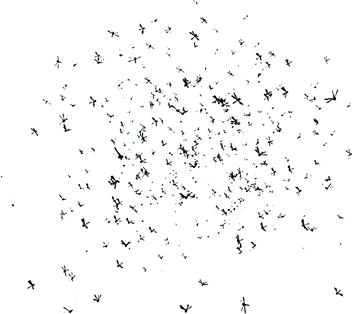
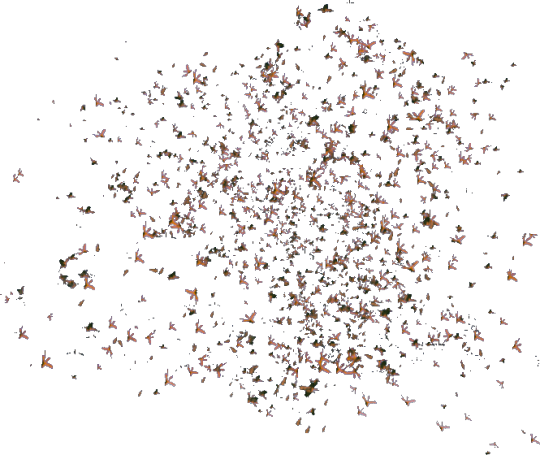
[Image IDs: Two renders, one of a swarm of Deeptora Bough Wasps, followed by a swarm of Deeptora Honeycomb Bees /End IDs.]
I just started playing Deep Rock Galactic fairly recently, and I'm a big fan! There's a lot in the game for bug fans to enjoy, with the vast majority of wildlife within the rock and stone being bugs, although the bugs are all aliens and aren't very easily comparable to the real thing. Even still, as tends to be the case, we can still allegedly find our Hymenopteran friends amongst this collection of extraterrestrial exoskeletal animals! But how do these bugs from the Hollow Bough and Sandblasted Corridors compare to those of our world?
First off their appearance, and, I'll be honest, there's not a lot here to analyze on the bugs themselves visually. Understandably when there are hundreds of bugs attacking at once, the developers wanted to make these guys more like particles than individual 3D models. Regardless, we can still take in a few details from their silhouettes, in which we can see, in a design choice surprisingly similar to the Mask Hornets from Lethal Company, the Deeptora Bough Wasps are actually more dragonfly-like than any social wasp, with the only wasp I can think of to really compare them to being ichneumon wasps.


[Image Sources: jupiterswasphouse, ie myself, and The Pathless Wood | Image IDs: A photo of a great blue skimmer dragonfly perching on a rusted dark metal garden decoration, followed by an image of a relatively large male ichneumon wasp on a green leaf /End IDs.]
Luckily, they at least appear to have the right number of wings, with a pair of forewings and a pair of hindwings, although there doesn't seem to be any real indication of legs. As for the Bees, meanwhile, are less clear, although they have a similar shape, also don't have any visible legs, they have a slightly wider gaster, and the presence of proper hindwings is unclear.
However, just because the actual insects don't provide us with much visually, doesn't mean that they don't give us a little bit more to go off of in general, as they still, of course, have nests!


[Image IDs: Two renders of the nests, the former belonging to the Deeptora Bough Wasps while the latter belongs to the Deeptora Honeycomb Bees /End IDs.]
... and clearly, these are very alien structures, with the bees' nest not being too easily comparable to the arboreal slabs of wax made by the true honey bees of our world we typically think of, genus Apis. However, it may be easier to compare them to some of the nests of honey bees of a different genus, that being Trigona!
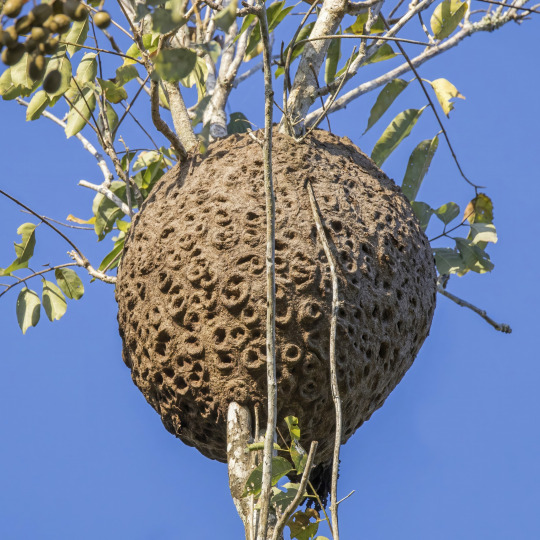
[Image Source: Wikimedia Commons, Sharp Photography | Image ID: A photo of a Trigona bee nest in a tree, the structure being very round with a multitude of holes /End ID.]
Obviously, it's not one-to-one! But, with its more enclosed shape and entry holes, it's a lot closer than those of genus Apis. We'll be returning to Trigona for other reasons later, but in the meantime, we'll move on to the Deeptora Bough Wasp Nest. Now, this nest is perhaps easiest to compare to paper nest making Vespids such as paper wasps, hornets, and yellowjackets. Although it seems to combine elements of the open, umbrella-shaped structures built by the paper wasps and the enclosed structures built by the hornets and yellowjackets.


[Image Sources: Flickr, Bob Peterson, and ResearchGate, Tshering Nidup | Image IDs: A real world photo of a nest of paper wasps, species Polistes major, subspecies major, followed by a photo of a Vespa mandarinia nest on the underside of a roof /End IDs.]
Although, again, it appears very alien, with a sort of red, angular, and glowing structure within the more paper-nest-like outer side of it. As previously mentioned in the It Takes Two Wasp Colony review, there are paper wasp nests that glow under UV, but these glow green, as opposed to red, and I'm uncertain how much ultraviolet light is found in the caves and mineshafts of Hoxxes IV.
Speaking of those caves, it's also worth noting that these nests are all found underground, which is not true of honey bees, nor paper wasps or hornets, this can be the case in some yellowjackets, which will build nests in holes relatively deep under the ground.

[Image Source: SMCMVCD | Image ID: An illustration of a yellowjacket nest that's been built underground, with a tunnel leading to the nest, a round structure made of paper /End ID.]
Furthermore, with regards to the number of insects within these colonies, it is stated in the bestiary that the Deeptora Honeycomb nest contains "10 million" drones, which is a strangely large number. For one, I'm not sure how that many bees fit inside these small structures, as even large nests in the real world contain "only" up to 80 thousand bees. Perhaps the tunnels extend further underground than they appear, but in game you don't seem to see the extensive tunnels below the nests that they would need to house them. Secondly, bee drones are, in fact, the males, meaning these ones would be incapable of stinging, not leaving the hive often. So how numerous, then, are the swarming workers? The log on the wasps is less specific, stating that they are actually more numerous, which seems to be inaccurate to their real world counterpart, although it's difficult to find proper numbers, as it appears that beehives generally contain more individuals than even the biggest of yellowjacket nests.
But what about their attacking behavior, then? Well, they seem to have the same general defensive behaviors, swarming and stinging players when they get too close to the nest, giving chase until the nest and the swarm are destroyed. They're a bit more aggressive than the eusocial Hymenopterans of our world, with mosts colonies only really attacking when directly disturbed in one way or another, although the dangerous environment of the caves may have made them evolve a more easily spooked demeanor.
The Bough Wasps are also described as being less aggressive than the bees, which is interesting, as it tends to be the case that eusocial bees are less aggressive than eusocial Vespids.
As for their feeding behaviors, the diet of the Bough Wasps is uncertain, as it's seemingly not mentioned, but it can be assumed that these wasps feed on the nectar of some sort of plant life given the surroundings of Hollow Bough. What is mentioned, however, is the feeding behavior of the bees, specifically being described as "flesh-eating".
Now, some of you may be thinking that there's no way there's a real world equivalent, as the eusocial bees of our world feed on pollen and nectar. However! Three examples can be found in the aforementioned genus Trigona! Trigona crassipes, Trigona necrophaga, and Trigona hypogea. These bees feed on carrion in place of pollen (Although, perhaps disappointingly to some, claims they make "meat honey" are inaccurate)! It can be assumed that the bees of Sandblasted Corridors do the same, as it is stated that they are "not particularly harmful towards Dwarves", therefore, likely not feeding on living sources of meat.
All in all, they're an interesting bunch! Clearly accuracy wasn't necessarily on their minds when making these guys, understandably so given that these are, in fact, alien in nature. Can't necessarily dock ti many points for that reason, though some things could have served to be a little more accurate. If I had to give a rating, I would say-
-
Overall: 5.5/10
-
Leave your wasp review suggestion in the replies, tags, or askbox!
21 notes
·
View notes
Text
Where Do Wasps Build Nests in Your Home?
Wasps like to build nests in places that are safe and dry. For example a hollow in a tree or crevice in a building is ideal nesting places. Most wasps’ nests are built in the open thus visible to human eyes. Some build nests underground such as a vacant rodent burrow or concealed places under grass or thicket. Most of these wasps are social wasps hence live in large numbers in a nest colony.
0 notes
Text
Florida Bugs Are Out of Control—Here’s How to Take Back Your Home (Without Losing Your Mind)
Picture this: You're sipping your morning coffee, ready to start the day, when a roach sprints across your countertop like it owns the place. 🙃
If you live in Florida, especially around Bradenton, Lakewood Ranch, North Port, Palmetto, Parrish, Port Charlotte, or Sarasota, you know this isn’t a rare event. It’s a lifestyle hazard.
And if you’re Googling things like “how to get rid of ants in Florida” or “pest control near me that doesn’t just spray and pray,” you’re in the right place.
Because Waves Pest Control is here to shut that buggy circus down—for good.
Bradenton Bugs Be Bold – Time to Bring in the Big Guns 🪳
In Bradenton, the pests don’t sneak in—they strut. German cockroaches, ants, mosquitoes, and termites treat your home like a vacation rental.
But with pest control in Bradenton, you can finally evict these freeloaders. Waves Pest Control offers targeted solutions for all the Bradenton-specific nasties. Whether you're dealing with lawn pests, attic invaders, or backyard biters, they’ve got you covered from the ground up.
Want full service with seasonal monitoring and long-term protection? Yep, Waves Pest Control Bradenton does that too.
Pest Control in Lakewood Ranch: Luxury Homes, Not Luxury Bugs 🏡🚫
You didn’t buy that beautiful Lakewood Ranch home just to share it with a colony of ghost ants or a family of spiders. You want those stunning views and clean baseboards—minus the crawling chaos.
Pest control in Lakewood Ranch with Waves is customized for local needs—meaning it works against Florida-specific pests like termites, silverfish, and wasps.
And unlike those one-size-fits-nobody services, Waves Pest Control Lakewood Ranch brings proactive, science-based strategies that keep your home pest-free all year long.
North Port’s Growing Fast—Unfortunately, So Are the Bugs 🐛
Termites in the garage? Fire ants in the mulch? Mosquitoes making your lanai un-livable? It’s just another Tuesday in North Port.
That’s why pest control North Port is non-negotiable. Waves is on a mission to stop the pests before they settle in. They’ll treat your yard, secure your entry points, and inspect for signs of deeper issues—all with eco-friendly options that won’t nuke your flowerbeds.
No drama. Just real North Port pest control solutions that actually stick.
Palmetto Living Shouldn’t Include Palmetto Bugs 🏖️🪰
Let’s get one thing clear: Palmetto bugs are roaches. Big, bold, and built like mini helicopters. And in Palmetto, FL, they’re basically part of the HOA (uninvited, of course).
With pest control in Palmetto, you can take back control. Waves Pest Control offers everything from lawn pest treatment and perimeter sprays to in-wall solutions and mosquito reduction—tailored for the hot, humid Palmetto climate.
Need monthly service? Done. Prefer quarterly visits? Waves Pest Control Palmetto has plans to match your life (and bug) schedule.
Parrish Pest Control Is All About Prevention (and Peace) 🌾
Living in Parrish has its perks—space, quiet, charm. But those wide-open spaces? Prime real estate for termites, rodents, and ants who don’t pay rent.
Pest control Parrish helps protect your home from the inside out. Whether you’re dealing with bugs in the barn or spiders in the sunroom, Waves keeps things under control—so you don’t have to suit up every time you go into the garage.
And yes, Waves Pest Control Parrish makes sure your pest control is as low-hassle as possible. You get reminders, fast responses, and zero surprises.
Pest Control in Port Charlotte: Bye, Bugs. Forever. 🕸️
There’s “occasional pests,” and then there’s Port Charlotte—where it feels like bugs have frequent flyer miles. From wasps to whiteflies, spiders to scale, pest control in Port Charlotte needs to be thorough, frequent, and Florida-smart.
Waves brings tailored services for Port Charlotte homes, including barrier treatments, attic dusting, and advanced options for lawn and landscape pests.
If you’re tired of playing whack-a-mole with ants, get Waves Pest Control Port Charlotte on the job.
Sarasota Homes Deserve Pest-Free Peace 🎭🌴
Sarasota has it all: world-class beaches, beautiful homes, and unfortunately, some of Florida’s peskiest pests. Termites thrive in historic districts. Mosquitoes swarm near the bay. And ants? They show up everywhere.
With pest control Sarasota, you’re not just getting a technician with a sprayer—you’re getting a proactive plan to protect your property year-round. From barrier treatments to in-wall systems, Waves uses proven, localized solutions that align with your home’s needs and Florida’s cycles.
Want reliable, no-BS service? Waves Pest Control in Sarasota is it.
TL;DR: Florida Bugs Are Relentless—Waves Is More Relentless 💪
This isn’t just about bugs. It’s about your sleep, your sanity, and not having to nervously peek behind the toilet at 2am. ��
No matter where you are, Waves Pest Control has your back:
✅ Pest control in Bradenton ✅ Pest control in Lakewood Ranch ✅ Pest control in North Port ✅ Pest control in Palmetto ✅ Pest control in Parrish ✅ Pest control in Port Charlotte ✅ Pest control in Sarasota
Whether it’s bugs in your kitchen, lawn pests eating your curb appeal, or termites threatening your foundation, you don’t need to DIY. You need Waves—and fast.
Ready to kick bugs to the curb?
Find your city and schedule your free inspection. It’s time.
Pest Control Bradenton
Pest Control Lakewood Ranch
Pest Control North Port
Pest Control Palmetto
Pest Control Parrish
Pest Control Port Charlotte
Pest Control Sarasota
0 notes
Text
This is so true, and something I'm trying hard to get people to understand. The universally reviled yellowjacket is not mindlessly aggressive and does not hate humans. Listen, I have had these things hover around me, land on me, lick up drops of melting popsicle from my table. I can walk carefully through a bunch of them who are sipping from flowers or drinking mud and they just calmly move out of the way. I have accidentally put my foot on a yellowjacket burrow and had one hover and politely wait for me to realize my error and withdraw my foot. I have lived with yellowjackets for nearly two decades now, had them nest in my yard every summer, and never been stung. So either I'm some kind of supernatural Wasp Whisperer, or everyone else is doing it wrong and these gals are DEEPLY misunderstood.
(Ditto for the bald-faced hornet, a member of the yellowjacket genus that's also supposed to be viciously aggressive to anyone near the nest, but the colony who built a nest on our bird feeder this past summer never stung anyone and would let me look at their pretty nest from 3 feet away. Don't even mention the paper wasps, who literally know my face and let me paint the trailer walls around their nests despite chasing off my neighbor when he tried it. I could probably let those guys eat out of my hand.)
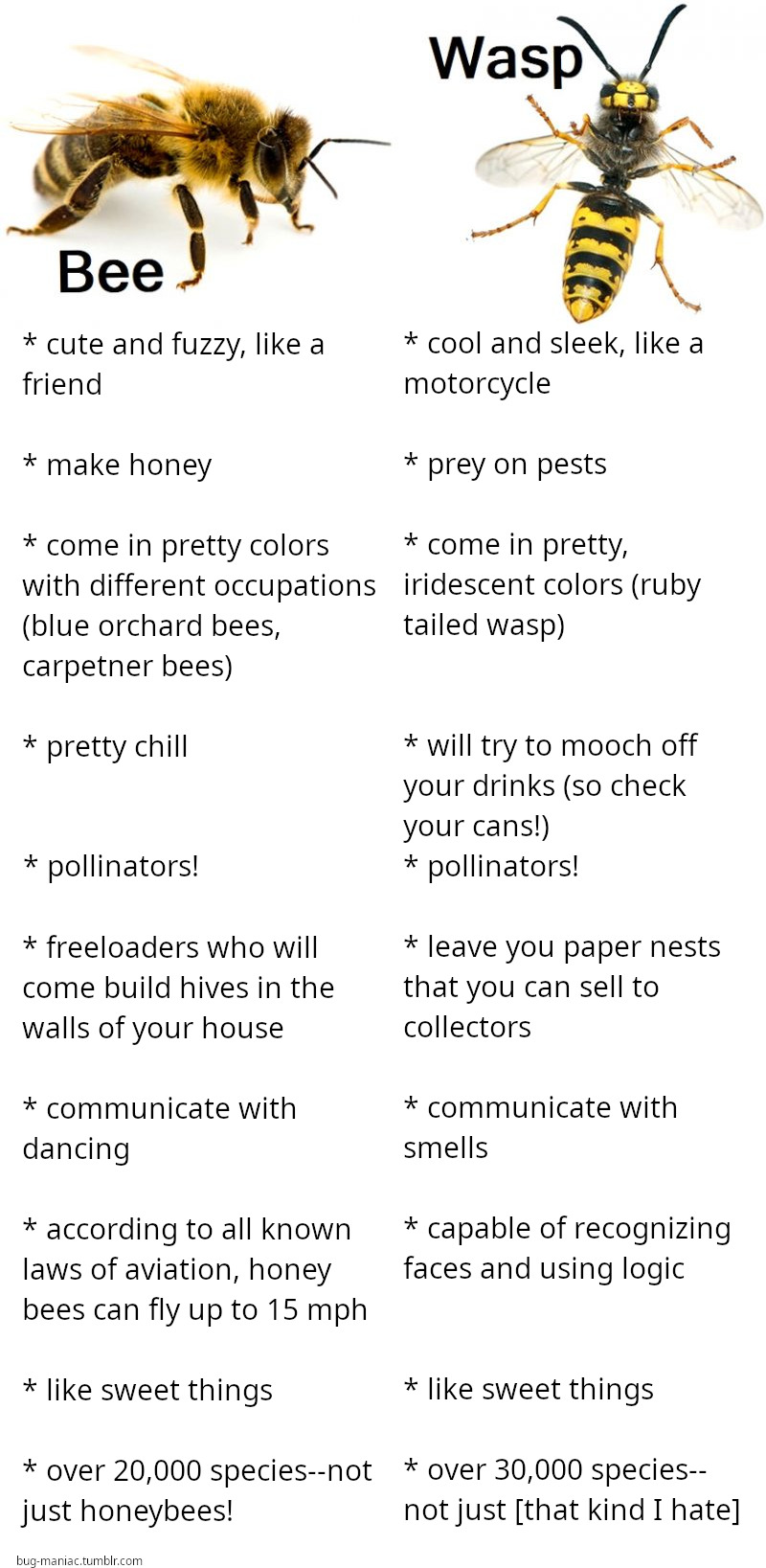
[Image ID: A picture of a bee and a wasp, both labeled. Both are colored yellow and black. Facts are listed about each one in their respective columns.
Bee:
Cute and fuzzy, like a friend
Make honey
Come in pretty colors with different occupations (blue orchard bee, carpenter bee)
Pollinators!
Freeloaders who will come build hives in the walls of your house
Communicate with dancing
According to all known laws of aviatin, honey bees can fly up to 15 mph
Like sweet things
Over 20,000 species--not just honeybees!
Wasp:
Cool and sleek, like a motorcycle
Prey on pests
Come in pretty, iridescent colors (ruby tailed wasp)
Will try to mooch off your drinks (so check your cans!)
Pollinators!
Leave you paper nests that you can sell to collectors
Communicate with smells
Like sweet things
Over 30,000 species--not just [kind I hate]
At the very bottom, in smaller text, is the URL bug-maniac.tumblr.com. /End ID]
NO ANTI-WASP SENTIMENTS ON THIS POST
#my partner still winces when a yellowjacket lands on me#but is slowly getting past it#she got stung a lot as a child and is understandably more reserved than I am#ftr our wasp neighbors have never stung her either. or the kiddo
26K notes
·
View notes
Text
The Importance of Professional Pest Control Services

Pests are more than just a nuisance—they can pose serious health risks, damage property, and disrupt the comfort of your home or business. Whether it’s ants marching through your kitchen, termites silently chewing through your walls, or rodents leaving droppings behind appliances, pest infestations are problems that require swift and effective action.
While DIY methods might seem like a convenient and affordable solution, they often provide only temporary relief and may fail to address the root cause. That’s where professional pest control services come in. With trained technicians, strategic treatments, and long-term prevention plans, these services offer peace of mind and reliable protection for both residential and commercial properties.
Common Pests That Require Professional Control
There are countless types of pests, but some are more common and troublesome than others. Here are a few that frequently invade homes and businesses:
Ants: Often drawn to food and moisture, ants can quickly establish colonies that are difficult to eliminate without targeting the source.
Cockroaches: These pests are known for spreading bacteria and triggering allergies. They’re particularly resilient and thrive in hidden, moist environments.
Termites: Silent destroyers that can cause extensive structural damage before being detected.
Rodents: Mice and rats can chew through wires, contaminate food, and spread disease.
Bed Bugs: These tiny insects feed on blood and are notoriously hard to get rid of without professional heat or chemical treatments.
Mosquitoes and Flies: Besides being annoying, they can carry harmful pathogens that threaten human health.
Other pests such as spiders, fleas, wasps, and wildlife (like raccoons or squirrels) may also require specialized removal and exclusion techniques.
Why Professional Pest Control Is Worth It
Professional pest control is more than just spraying chemicals—it's a strategic approach built on expertise, science, and safety. Here’s why hiring professionals is often the best solution:
1. Accurate Pest Identification
Knowing what kind of pest you're dealing with is crucial to effective treatment. Professionals are trained to identify pests correctly and understand their behavior, breeding habits, and vulnerabilities. Misidentifying a pest can lead to using the wrong methods, which often worsens the problem.
2. Customized Treatment Plans
Every infestation is different. A professional pest control provider will assess your specific situation and design a treatment plan tailored to the pest type, property layout, and severity of the issue. This targeted approach ensures better results than one-size-fits-all sprays or store-bought traps.
3. Long-Term Prevention
Professional services don’t just treat the symptoms—they address the root causes. Technicians will often identify entry points, eliminate nesting areas, and recommend changes to prevent future infestations. Many companies offer ongoing maintenance plans to monitor and prevent pests all year long.
4. Safe and Responsible Use of Chemicals
Many pests require chemical treatments, but improper use can be dangerous to humans, pets, and the environment. Pest control experts know how to apply pesticides safely, minimizing exposure while maximizing effectiveness. Many providers also offer eco-friendly or low-toxicity options.
5. Time and Cost Efficiency
While it might seem cheaper to try DIY methods, repeated failures and worsening infestations can become expensive and stressful. Professional services often solve the problem faster and more efficiently, saving time and reducing long-term costs.
6. Peace of Mind
Living or working in a pest-infested space is uncomfortable and stressful. Knowing that experts are handling the problem gives you the confidence and comfort you need to focus on your life or business.
Pest Control for Homes and Businesses
Residential Pest Control
Your home is supposed to be a place of comfort and safety—but pests can quickly ruin that. Residential pest control services target common household pests and offer family- and pet-safe solutions. From kitchens to basements, professionals know where pests hide and how to get rid of them effectively.
Some providers also offer seasonal services to combat pests as they become active throughout the year—like ants in spring, mosquitoes in summer, and rodents in fall and winter.
Commercial Pest Control
Businesses face unique pest challenges. A single infestation can damage products, scare customers, or result in health code violations. Whether you run a restaurant, hotel, office, or warehouse, professional pest control services can provide:
Discreet treatments during off-hours
Compliance with industry regulations
Documentation for audits and inspections
Long-term contracts for regular monitoring
Commercial-grade pest control is not only reactive but also highly preventive, ensuring that pest problems never interfere with operations.
Tips for Pest Prevention
While professional pest control is the best way to eliminate infestations, prevention starts with good habits. Here are some general tips to reduce the risk of attracting pests:
Seal entry points: Close gaps around doors, windows, pipes, and vents.
Keep your space clean: Wipe down surfaces, store food in sealed containers, and empty garbage regularly.
Fix leaks: Pests are drawn to water sources, so repair leaky pipes and reduce moisture in areas like basements and bathrooms.
Trim vegetation: Keep shrubs and tree branches away from your home or building to reduce pathways for pests.
Remove standing water: Especially important for controlling mosquitoes.
Regular inspections and proactive maintenance can catch issues before they escalate into major problems.
Final Thoughts
Pest problems are more than just a temporary annoyance—they can be damaging to your health, property, and peace of mind. While do-it-yourself efforts might offer quick fixes, they often fall short in tackling deeper infestations or preventing recurrence.
Professional pest control services provide a comprehensive solution that includes expert diagnosis, safe treatment, and long-term protection. Whether you’re a homeowner trying to keep your space comfortable or a business owner ensuring a clean, compliant environment, investing in pest control is a smart decision.
With the right support and regular maintenance, you can enjoy a pest-free environment and the comfort that comes with it.
1 note
·
View note
Text
The Wild Child’s Delight
By David Colman Sept. 23, 2007
YOU would expect Eartha Kitt to profess a love for swans, so much does her own tale share with “The Ugly Ducking,” the little gray cygnet who, shunned at childhood, grows up to be a lithe, lovely international recording artist.
“I was a yellow girl, neither black or white,” she said matter of factly. “Everyone told me I was ugly.”
Ms. Kitt recalled that she did not spend her solitary Depression-era childhood reading fairy tales, but in the fields picking cotton, and off-hours in the woods around the tiny town of North, S.C.
Cut to Paris, 1950. Cue Champagne.
Today, living in woodsy Connecticut, she spends more time immersed in the Discovery Channel. Combined, her childhood experiences and adult crash course in zoology have given Ms. Kitt a keen appreciation for many things, but none more than the ominous piece of apia-tecture known colloquially as the hornets’ nest.
Ominous to some, at least. “I don’t find them frightening,” said Ms. Kitt, whose legendary purr-cum-growl is performing at the newly redone Cafe Carlyle, through Oct. 27. “I think they’re fascinating, so intricate. I love all kinds of bees’ nests. I was a wild child, and I depended on the forest to find company when I was a kid, so I became very cognizant of how friendly nature can be.”
To wit, Ms. Kitt was once photographed by Jet magazine amid a pride of lions in Africa, and appeared in a low-budget movie (“The Serpent Warriors,” 1985) in a bed of snakes. Neither compared, she said, with facing an audience of people, beside whom a swarm of bees is a breeze. “With bees, all you have to do is outrun them,” she said. “I know from experience.”
She started collecting nests about 25 years ago in New Milford, Conn., when a farmer gave her one, then another. “The architecture is so amazing,” she said, “the way that they’re built from the inside out, and gradually expanded as the summer goes on. I’d love to see a documentary just on them.”
The prize of her modest collection is one that is perfectly intact, still on the branch where it was built, given to her by a neighbor boy when she was living in Pound Ridge, N.Y., some 10 years ago. Roughly the size, shape and weight of a large bouffant hairdo, it is most likely the product of a hive of bald-faced hornets, actually a species of wasp.
Though a fearsome sight to many, the hornets’ nest is actually a paragon of eusocial behavior, a way of creating and procreating practiced by some animals that for a while befuddled Darwin. All the hornets (the sterile drones and workers and the fecund queen) contribute to making the nest, some chewing wood to create the ever-expanding paper skin, others constructing the tissue-thin hexagonal interior grid where larvae are hatched — a grid that has fired human imagination, from Frank Lloyd Wright’s to Marc Newson’s.
“It really takes a colony," Ms. Kitt said, pointing out how important bees and wasps are to human life, a point brought home recently with the mysterious death of many American bee colonies. “You really get to a point where you realize how important evolution is, and see that we’re all connected.”
Still, Ms. Kitt acknowledged that this kibbutz on a stick does come with a stinger. “There is very much a feeling of a power on their side,” she said, describing the ineffable threat of a swarm of bees. “You don’t want to take any chances. There are so many ways for them to attack.”
But if the Kitt vision of nature were to be believed, there is no reason to fear. “The only reason they attack is if you attack first. As long as you leave the queen alone, you don’t have to worry,” she said, shrugging. “Just always leave the queen alone.”
You heard the lady.
0 notes
Text
It became popular with people in power because it justified their way of life, but it was a tough sell to common people. The Puritans were Calvinists, as they said above. Most people in England hated them, though. Shakespeare wrote mocking caricatures of them, too, (Malvolio) and they were bullied out of England and sailed on over to the New World. So the whole “religious freedom” narrative that primary school American history is built on and most Americans use to justify colonialism and prejudice and greed … it is the DNA of Calvinism. It is being a WASP, or a White Anglo-Saxon Protestant. And it’s why so many white people don’t dance and work all the time and are great at subjugating others and not complaining about their bosses. If you go back to high school American history or any American media with this lens, so much that is glorified and made the US a rich, powerful empire is this perfect mix of capitalists and workers who will worship a boot on their neck … and that’s why white nationalists and rich people are scared of diversity, rest, equity, education, and globalism.
Me, starting a video that says it's going to explain how Victorian poorhouses fucked up the concept of charity forever: ok, show me what you've got
Video: it starts with the ideas of the Christian philosopher --
Me: DON'T SAY IT DON'T FUCKING SAY IT
Video: -- John Calvin
Me:

23K notes
·
View notes
Text
Session 5 - Spelljammer
August 24, 2024
Armed with the knowledge and motivation that one only finds at an indie bookstore, the team returns to the ship, ready to begin their next quest - The location and retrieval of the Fey prince of Spring, Emerald!
During the journey, Frank uses books and HIS MIND to learn more about the ship. His current topic of study, troubleshooting and the basics of the energy of ship building.
With every Glark book read, add d4 to checks related to spelljamming. Current level = 3d4
As they approach the planet Anadia, Gar spots a derelict, wasp-shaped ship. As they approach, they find this ship silent and un-moving, massively damaged on the bow. Stew enters his fancy new mind palace and tries to sense if anyone is left alive. Despite the dead appearance of the ship, he finds that there is someone…or something…alive on the ship. The crew gets suited up and heads over.
Upon entering the ship, they find the neatly preserved aftermath of scenes from what looks to be a nightmare. A very dead crew in varying scenes of horrific death leads Stew to the presence he sensed back on the ship. He can feel the presence move and try to escape the ship, but remain invisible to the eye. Stew attempts to make a telepathic connection, but sees images of only death and pain. Stew attempts to send good vibes by showing the creature a sunset. It turns out to be the wrong move and Stew immediately gets grappled by a very angee tentacle.
The party attacks with various successes. The creature bites Stew’s tender meats and frightens Finnley. Rude. Our heroes don’t quite get the HP meter down to zero and the creature flees the ship, making its way to the planet. After some thinking, Frank determines the creature was a Fyre, a space vermin who feeds on nightmares.
Knyle finds a well placed travel journal clutched in the hands of the dead captain. The crew were elvish emissaries from the Seelie court working on behalf of the Summer court of Fey. Their quest…to find the lost colony of Astral elves, a lost branch of the family. As the crew slowly dissolved into madness, they were hit by an asteroid and succumba’d to the vaccumba of space…a sad tale indeed.
FINDS
General: Letters and Manifesto for Queen of Seelie Court Ship manifest Warding spell scroll Invisibility potion Bag of Elvish gold coins (100gp) Food rations for 3 months Additional 200 gp
Finnley
Elvin master work shield (+1)
Frank
Boot of Elvin Kind Walk without sound, advantage on stealth checks for walking quietly
Gar
Circlet of Blasting Action to cast scorching ray, Attack bonus +5, Once per day refresh at dawn.
Stew
Master work retracting magic scimitar (+1)
Knyle
Magical Elvin Thome of Skills of Rhetoric and Persuasion (Public Speaking)
The damaged wasp ship has a bug zapper defense mechanism. It is covered in metal places and can redirect energy to electrify the plates. The team strips the ship to add this to their own ship. TO USE: Plates will need to be installed on the outside and a converter will need to be built and installed at the helm.
After this wild distraction, the crew gets back to their ship and continues their quest. Once they get around the sun, they find an asteroid, which Stew notices is entirely green. Squinty eyed suspicion.
They land in what seems to be a jungle. It's very lush and Finnley is able to get out of his suit and go for a refreshing swim. They follow large bear tracks to a cave. Stew is able to sense there is a presence directly below them, so he continues into the cave. They follow the path and walk down, down, down, until they find the center of the asteroid, which is mostly hollow, a pinpoint of light shining in the center. They follow the pathway down the sides of the walls. They walk through a forest of large trees. An over-sized bear creature, assumed to be the one they were tracking earlier, seems to be felling and dragging quite a few of them towards the presence Stew was sensing. They follow and find a clearing - a quaint vegetable garden, and a small wooden cabin of Elvin make.
The runes on the front door do nothing to dissuade our heroes, as they proceed to throw caution to the wind and just…well knock. Immediately, vines shoot up from the ground and grapple everyone, with the exception of Gar and Frank Jr.
With a flair of dramatics everyone should have expected, one of the vines stretches out and opens the door to reveal an Eladrin lounging on a couch, holding a cup of tea, surrounded by woodland creatures.
Is this the mysterious missing Fey prince? Will anyone on the crew fall in love with him and have an epic romantasy novella side quest? Will the bear get to take a honey break? Tune in next week! (Or in 6 months, 'cause babycakes, we all have day jobs.)
0 notes